By Alex Tang
“O God, you will show me the path of life and fill me with joy in your presence.”
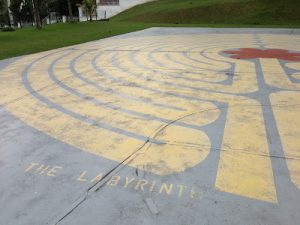
Labyrinth at Lifesprings Canossian Spirituality Centre, Singapore
A labyrinth is a pattern on the ground in which there is a long pathway that leads to the centre. Once reaching the centre, you may follow path back to the entrance which is also the exit. Generally, there are three stages to the walk: releasing on the way in, receiving in the center and returning when you follow the path back out of the center of the labyrinth. Symbolically, and sometimes actually, you are taking back out into the world that which you have received.
The first documented example of a labyrinth we have is from 324 A.D. when Christians placed a labyrinth on the floor of their church in Algiers, North Africa. Many of the early church fathers including Ambrose, Gregory of Nyssa, and Jerome wrote about labyrinths as a metaphor to illustrate important Christian beliefs.
There is no right way or wrong way to walk a labyrinth. Use the labyrinth in any way that meets your needs while being respectful of others who may be walking on the path. You may stop anywhere along the path to mediate, pray or be in silence. You will often meet others walking the path in the opposite direction. Simply step around them. Walk at your own pace; you may even pass others who may be in front of you. Take your time. Walk slowly. Do what feels natural to you — some walk steadily, some cover their faces with scarves, some dance, some twirl and dance, some stop often. At the center you may sit, kneel, stand, change positions or directions, pray, meditate, or do silent reading or writing.
“Be still and know that I am God.”
Psalm 46:10
To prepare for walking, you may want to sit quietly to reflect before stepping onto the labyrinth. Some people come with questions, others just to slow down and take time out from a busy life. Some come to find strength to take the next step. Many come during times of grief and loss.
In walking the labyrinth with the psalms, we are to read a psalm while walking the labyrinth. Select a psalm from the list below or choose one of your own.
Psalms 1; 8; 23; 27; 42; 46; 48; 63; 84; 108; 111; 139; 143; 147
The idea is to stick to meditating/praying one particular psalm for the whole duration of this walk, using it to pray, meditate and contemplate. Read the psalm slowly. Meditate and listen to each word, sentence and paragraph. Restart at the beginning of the psalm when you have reached the end.
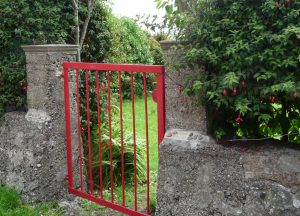 By Lilly Lewin
By Lilly Lewin
This week’s lectionary readings move us from the resurrection story back to the gospel of John.
In John 10:1-10 we are called to reflect on Jesus as the Gate and invited to look at ourselves as sheep.
Many of us in America don’t grow up around sheep so often being told we are like sheep doesn’t help us. Most of us have never spent any time with them. When I was in 7th grade, my family moved to the farm from the suburbs. My dad thought it would be good for us to learn about farming and farm animals. I like to say that he wanted us to be the 1890’s farm family, and live off the land way before it was retro and cool to do so. The first couple of years we lived on the farm we had a sheep named Sally. Sally was my first introduction to what sheep are like, and she gave me a real-life picture of how sheep behave, and why I am too often really like a sheep. I learned that sheep’s makes it easy for a predator like a coyote to grab on to the sheep and drag it down to kill it. Sheep really do need protection. They need a shepherd and a sheepfold or pen to protect them from harm. When Sally felt threatened, like after she her had twin lambs, and she thought I might harm them, Sally would snort and stomp her foot at me. That was her only defense, stomping her foot and giving a snort. That was her way of saying “just stop right there.” I realized that I’m a lot like Sally. Too often I snort and stomp my foot at God when I don’t like what God is up to or when I don’t understand it
Too many of us live in the city or in the suburbs, so we miss the symbolism of the sheep, and of gates too. We might have a front gate or a back gate in and out of the yard, but many of us don’t even have that around our homes. We just go to the door, or walk down a walkway or hallway in an apartment building with not a gate in sight. So it takes some work to think about gates, and sheep and shepherds.
What about you? What do you know about sheep? Have you ever felt like a sheep? Do you ever feel like my sheep Sally?
This past Sunday, at our thinplace gathering, we used John 10:1-10 (this Sunday’s gospel reading) for our lectio divina, and we prayed the psalm 23 as our opening prayer. In preparation for this Sunday, or if you don’t follow the lectionary readings, take some time to consider John 10:1-10 and read and listen to Psalm 23 on your own, with your family, or roommates or small group and give yourself time to ponder Jesus as a gate and yourself as a sheep who hears his voice..
The process we use is listening to the gospel passage read aloud in three different voices. If you are doing this on your own, just read slowly and allow the Holy Spirit to highlight a word or phrase for you. What pops out to you? What do you notice that you didn’t notice before?
Lectio divina, or divine listening, is a practice that allows us to hear a familiar scripture passage in a new way, with new ears. We hear new things, and allow the Holy Spirit to highlight the scripture passage for us for today. Yes, we bring to the hearing what we have learned and known before, but the idea is to allow God to speak to us today and impact us right now. What does this passage mean for me today? What is the Holy Spirit revealing to me right now, not from my years of sermons or teachings I have heard or led? But rather, what is my gift from God in this passage? What is my response? How is God asking me to respond? I often ask the Holy Spirit to act as yellow highlighting pen/marker as I read or listen, and make marks on the page, circle words and write down questions that come up as I listen to a passage. And since I am a visual learner and an artist, I think about the images and picture myself in the story. Listen to the passage and let it speak to you for today.
Read John 10:1-10 and Psalm 23
Use Psalm23 and/ or the Gospel passage as your inspiration to write or to create art. Allow the Holy Spirit to inspire you! You can use the questions that follow as guides for your journaling and for art.
John 10:1-10
Jesus said, “Very truly, I tell you, anyone who does not enter the sheepfold by the gate but climbs in by another way is a thief and a bandit. The one who enters by the gate is the shepherd of the sheep. The gatekeeper opens the gate for him, and the sheep hear his voice. He calls his own sheep by name and leads them out. When he has brought out all his own, he goes ahead of them, and the sheep follow him because they know his voice. They will not follow a stranger, but they will run from him because they do not know the voice of strangers.” Jesus used this figure of speech with them, but they did not understand what he was saying to them.
So again Jesus said to them, “Very truly, I tell you, I am the gate for the sheep. All who came before me are thieves and bandits; but the sheep did not listen to them. I am the gate. Whoever enters by me will be saved, and will come in and go out and find pasture. The thief comes only to steal and kill and destroy. I came that they may have life, and have it abundantly.”
John 10:1-10 The Message
10 1-5 “Let me set this before you as plainly as I can. If a person climbs over or through the fence of a sheep pen instead of going through the gate, you know he’s up to no good—a sheep rustler! The shepherd walks right up to the gate. The gatekeeper opens the gate to him and the sheep recognize his voice. He calls his own sheep by name and leads them out. When he gets them all out, he leads them and they follow because they are familiar with his voice. They won’t follow a stranger’s voice but will scatter because they aren’t used to the sound of it.”
6-10 Jesus told this simple story, but they had no idea what he was talking about. So he tried again. “I’ll be explicit, then. I am the Gate for the sheep. All those others are up to no good—sheep stealers, every one of them. But the sheep didn’t listen to them. I am the Gate. Anyone who goes through me will be cared for—will freely go in and out, and find pasture. A thief is only there to steal and kill and destroy. I came so they can have real and eternal life, more and better life than they ever dreamed of.
Things to Consider while Journaling
*How has God been your shepherd or your gate?
*What thieves or bandits are robbing you of peace or joy in your life? What sheep rustlers are stealing from you?
*What things help you know God’s voice? Or Jesus’ voice? When and How do you feel closest to God?
*How does it feel to know that Jesus knows your name? What would it take for you to truly believe this?
*What is abundant life to you? What does abundant life look like?
*How do you need Jesus to be a gate in your life right now?
*How do you need his protection? His care? Or Does the Gate need to swing open in some way for you right now?
As you open and close gates in your life this week and in the days and weeks to come, or if you happen to have sheep in your life, allow Jesus to speak to you through these things. And take time to listen for the voice of the Shepherd.
Check out these two videos from youtube…one is on the shepherd calling his sheep and the other is an interesting look at psalm 23.
https://www.youtube.com/watch?v=e45dVgWgV64 Sheep know their the shepherd
https://www.youtube.com/watch?v=8z_1dING_uI Rabbi on Psalm 23
Learn more about Lectio Divina https://en.wikipedia.org/wiki/Lectio_Divina
freerangeworship.com 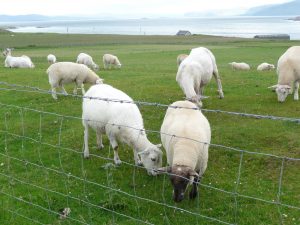
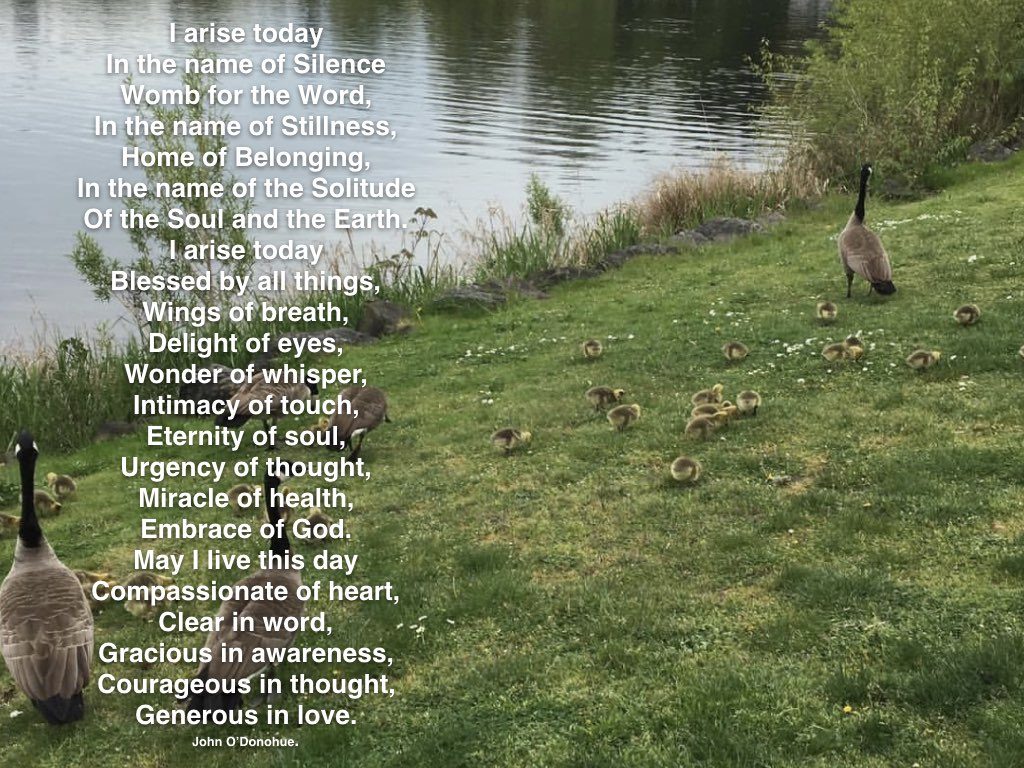
by Christine Sine.
Tom and I have just returned from a wonderful walk around Greenlake. We are so privileged to live close to this beautiful sanctuary. Sometimes we walk in the morning, sometimes at noon and sometimes in the late afternoon. I relish the changing patterns of the water, sometimes serene and tranquil, sometimes angry and choppy. I drink in the beauty of the emerging green and the profusion of blossoms that surround me. And today, my first glimpse of the new ducklings and goslings.
I am indeed blessed by all things as John O’Donohue reminds us in this beautiful poem from To Bless The Space Between. I am filled with the joy of God’s resurrection world and I pray that you too will pause, read through this poem of blessing and take notice.
(As an Amazon Affiliate I receive a small amount for your purchases made through this link)
By Britni D’Eliso —
Every lazy summer evening and crisp autumn walk, I question whether or not spring truly is my favorite season.
And every time I see the first bright daffodil braving the winter gusts and smell the fresh air after the first fall of rain, it’s confirmed: Spring is hands-down my favorite time of the year. Nothing beats the emerging glimpses of new life as the snow is melting and the earth is rebounding from the harshness of winter. Spring marks the return of vibrant colors and baby animal songs and no more defrosting the car windows early before work!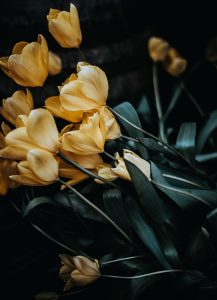
Even more importantly, spring reminds us that God redeems. He has established a creation that goes dormant each year, and faithfully springs up with renewed life within his perfect timing. For every downed branch in a winter storm, there is a brilliant bloom that pushes through the hardened earth to sing of new life.
Each year we embark on growth. We are welcoming one another into the garden of the life God has established to nourish his children. As we dig into (pun fully intended) scriptures and meditations that reference growth, gardens and new life, I invite you to explore patterns of regeneration, restoration and redemption that God might be working in you this spring.
This is what the Lord says—
he who made a way through the sea,
a path through the mighty waters,
who drew out the chariots and horses,
the army and reinforcements together,
and they lay there, never to rise again,
extinguished, snuffed out like a wick:
“Forget the former things;
do not dwell on the past.
See, I am doing a new thing!
Now it springs up; do you not perceive it?
I am making a way in the wilderness
and streams in the wasteland.
The wild animals honor me,
the jackals and the owls,
because I provide water in the wilderness
and streams in the wasteland,
to give drink to my people, my chosen,
the people I formed for myself
that they may proclaim my praise. Isaiah 43:16-21
Britni is a quiet but fearless spirit who is earnestly seeking the beauty of the redemption that Jesus has personally determined for her life. Committed to the truth that listening breeds understanding and understanding results in compassion, she clings to the power of life’s stories. She has embarked on the venture of discovering her own story and lending an ear to the stories lived out in others and savors the trace of Jesus that is woven throughout them all. Currently, that journey has landed her in a balancing act between the role of wife, momma, and a mental health therapist.
Now the Lord God had planted a garden in the east, in Eden; and there he put the man he had formed… The Lord God took the man and put him in the Garden of Eden to work it and take care of it.”Genesis 2:8,15
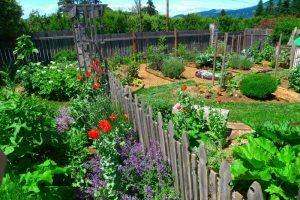 God was the first gardener. Creating and establishing the first trees, shrubs, and other forms of vegetation, then placing humankind into the garden, God establishes what a healthy relationship between humankind and the rest of creation is to look like. The most literal translations have God charging us not to exploit, but to care for and tend the creation God called “very good”.
God was the first gardener. Creating and establishing the first trees, shrubs, and other forms of vegetation, then placing humankind into the garden, God establishes what a healthy relationship between humankind and the rest of creation is to look like. The most literal translations have God charging us not to exploit, but to care for and tend the creation God called “very good”.
Jump forward to Resurrection Day. Mary mistakes the risen Jesus for a gardener and that, he was! All those references he made to seed and death and life are now embodied in his resurrection.
Of course, none of this is new, but it did get me thinking. As I plan for this year’s garden, start seeds in our little sunroom, and prepare the garden beds for planting, I can’t help but reflect on how these simple acts relate to God’s profound acts of love and grace as God walks with creation throughout history.
Take a moment to reflect on Genesis chapter 2:
- Do you see your relationship with creation as one of a caretaker?
- Are there ways you might change how you live to better reflect God’s command to nurture and care for creation?
- List three practices to begin this week to move closer to God’s design for us as caretakers.
Now imagine all of your life experiences and actions as those of a gardener:
- What are your favorite things to “plant”?
- What things do you spend most of your time “tending and nurturing”?
- When looking at your life-garden, what do you “water”?
- What things could benefit from more water?
- Are there things that need “pruning”?
- What are they, and how might you begin this week to approach them?
- Are there “plants” that are invasive, taking over, and need to be eliminated?
Finally, imagine your garden as a place of hospitality and sharing:
- How do you share your “harvest”?
- Are there things you just make available for others to glean?
- Are there “garden beds” you help prepare for others to plant in?
- What are they, and how do you nurture the best soil possible for others?
Using the language of gardening is a thought-provoking way to look at our lives and the choices we make. For me, the metaphor gives me a creative way to evaluate my choices and actions and frees me to see new ways of approaching areas where I’ve previously been stuck. It also helps to expose attitudes and actions I hadn’t even considered, blind spots that really don’t line up with the faith I profess.
Please comment below and let me know if this exercise is helpful. And share your questions and ideas that go beyond the ones I’ve listed above.
 Andy and Christine will be leading a curated lunch during the Inhabit Conference in Seattle (April 28-29) exploring the connections between gardening, hospitality, and shalom.
Andy and Christine will be leading a curated lunch during the Inhabit Conference in Seattle (April 28-29) exploring the connections between gardening, hospitality, and shalom.
QUEEN BERTHA OF KENT, A PREPARER OF THE WAY
Feast Day, May 1
c539-c612
Aren’t we grateful for those who prepare the way for us? Jesus had his cousin John the Baptist who walked ahead of him and prepared the way by plowing the hard hearts of the people and allowing the seeds planted by Jesus to grow, to flourish, and to come to fruition. Queen Bertha of Kent, in the likeness of John the Baptist prepared the way for Anglo-Saxon England to receive the Gospel.
Bertha was a Frankish princess who was likely born about 539 and brought up in Tours, France. Her father was Charibert I, the Merovingian King of Neustria, which was the western part of the Frankish lands with its capital in Paris. Her mother was Ingoberga, the first wife of Charibert I. Ingoberga was known for her Christian piety and a generous supporter of the church in Tours. Bertha was also the great-granddaughter of Clovis, the founder of the Merovingian dynasty of France and his wife Clothide who aided in the conversion of her husband to faith in Christ.
The Venerable Bede described Bertha as the “of the royal stock of the Franks.” This would have made her marriage to the pagan Anglo-Saxon King Æthelberht of Kent in England a great bonus to both the Anglo-Saxon king and to the Merovingian line in France. This marriage was likely brokered by King Chilperic of France who would have used the daughter of his deceased half-brother to extend his influence across the English Channel.
Bertha’s marriage to King Æthelberht was conditioned on her being allowed to practice her faith in Christ. To ensure that this stipulation was met, she brought her chaplain, Bishop Liudhard with her to England. Interestingly, in 1844 in the churchyard of St. Martin’s a late 6th c. gold coin or medal was found with an attached loop along with other gold coins in a late 6th c. grave. This gold piece bears a head surrounded with letters spelling out in mirror writing in Latin “Leudardus Episcopus” (Bishop Liudhard). It now resides in the World Museum in Liverpool.
Queen Bertha and Bishop Liudhard restored a Roman occupation era Christian church in Canterbury which had been dedicated to St. Martin of Tours. It became her private chapel even before Augustine arrived from Rome. The present St. Martin’s of Canterbury continues in the same building. It is the oldest church in the English-speaking world and is part of the Canterbury World Heritage site.
Much of the favorable reception that Augustine received for his mission when he was sent by Pope Gregory I to preach the gospel to pagan Anglo-Saxon England in 597 is owed to the influence of Bertha. Pope Gregory wrote to the Eastern Church’s Patriarch of Alexandria, Eulogius, reporting that by Christmas 597 more than 10,000 English had been baptized in just a few short months. In 601, Pope Gregory addressed a letter to Bertha, in which he compliments her highly on her faith and knowledge of letters.
Anglo-Saxon records indicate that Queen Bertha had two children: Eadbald who later became King of Kent and Æthelburga of Kent who married King Edwin of Deira (later part of Northumbria). King Edwin’s conversion to Christianity was linked to his marriage to Æthelburga who brought her chaplain, Paulinus, with her to Northumbria. Paulinus baptized Edwin and all of his family including both the young Hilda, the future St. Hilda of Whitby, and her sister, Hereswith, at the hastily built minster in York.
We can only imagine how difficult it must have been for this young Frankish princess to travel to another country to marry a pagan king she had never met. This marriage must have even been more difficult as she likely did not know the Anglo-Saxon language. Her faith and her chaplain helped guide her through this maze of unknowing into a place in which she prepared the way for Anglo-Saxon England to come to faith in Christ.
The strong women of faith in Bertha’s lineage were transformational to the kings and to their lands as preparers of the way of Christ. Bertha’s Burgundian great-grandmother Clothilde helped convert her husband King Clovis of France to faith in Christ. Queen Bertha herself aided in the conversion of her husband King Æthelberht of Kent and prepared the way for St. Augustine’s reception to preach the gospel in England. Queen Bertha’s daughter, Queen Æthelburga helped convert her husband King Edwin of Northumbria to Christianity that brought faith to this area of England.
Thank you God for sending those ahead of us to prepare the way for us to do the work you have sent us to do. These soul preparers are a sacred and holy gift from the Spirit and we thank you. Amen.
Today, we can walk on a path in Canterbury in honor of Queen Bertha as there is the Bertha Trail also known as the Queen Bertha’s Walk. This trail consists of fourteen bronze plaques set in pavement that includes St. Martin’s Church, St. Augustine’s Abbey, and Canterbury Cathedral.
Rev. Brenda G. Warren is an ordained Christian Church (Disciples of Christ) pastor. Her passion is for the early Celtic and Anglo-Saxon saints that she writes about on her website: www.saintsbridge.org. A bibliography of St. Bertha of Kent is available on the website.

by Christine Sine
Tom and I have just returned from one of our quarterly retreats. This time we relaxed in a beautiful hotel on the beach at White Rock in B.C. Canada. Much of my time was spend contemplating the following passage from To Bless the Space Between, by John O’Donohue.
Before it occurs a beginning can be a longtime in preparation….
When the heart is ready for a fresh beginning unforeseen things can emerge. And in a sense, this is exactly what a beginning does. It is an opening for surprises. Surrounding the intention and the at of beginning there is always exciting possibilities. This inevitably excites artists. So much can actually happen between the moment the brush is taken into the hand and the moment it touches the canvas. Such beginnings have their own mind and they invite us to unveil new gifts and arrivals in one’s life. Beginnings are new horizons that want to be seen; they are not regressions or repetitions. Somehow they win clearness and become fiercely free of the grip of the past.
As I reflected on this I realized how often I confuse the start with the beginning. A new project, a new vision, a new idea does not begin until it is fully formed and clarified in our minds. Yet the idea has started long before that.
As many of you know I am entering a new stage of life with a new vision and a new pathway. I am impatient for all the pieces to come together. I am ready to begin, but it is not yet time. God has reminded me that this is still a time of refreshment, relaxation and renewal. It is a time to wait for God to begin, to continue to compose the song of life that God has placed within my soul and allow it to be heard in new melodies when God has fully formed it. I am excited by what I see starting to emerge and look forward to sharing my new beginnings with you in the coming months.
What Is Your Response
As I continue this walk I find myself asking some new questions that you might like to reflect on too:
- What is my unique God given gift that the world needs to see?
- What is the new joy filled horizon God has placed within me that wants to be seen?
- How am I choosing to cultivate that gift and enable myself to move towards that choice?
Each day is a new beginning for all of us, a time in which unforeseen and sometimes surprising things can emerge. Sometimes these are small and seemingly mundane things like the emergence of a new flower in our garden or the visit of a friend. Sometimes they are monumental like the emergence of a new vision or direction in life as I am experiencing.
Whatever the beginnings that are before you take time to prepare and to reflect. Look back over your last couple of days: What unforeseen and surprising things emerged in them? Write them down. What new gifts have they unveiled for you? Write these down and offer a prayer of thanks to God.
Now look ahead to the coming days and imagine with joy and anticipation the new things that God is preparing for you: What is the new horizon in you that wants to be seen?
As an Amazon Associate, I receive a small amount for purchases made through appropriate links.
Thank you for supporting Godspace in this way.
When referencing or quoting Godspace Light, please be sure to include the Author (Christine Sine unless otherwise noted), the Title of the article or resource, the Source link where appropriate, and ©Godspacelight.com. Thank you!
